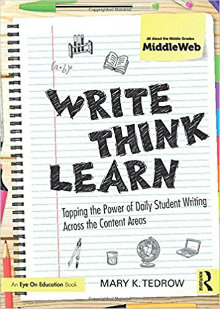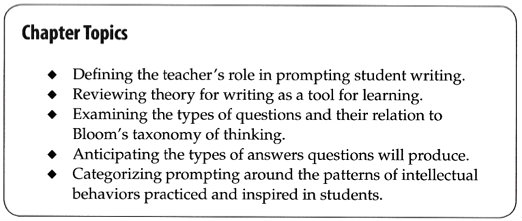All You Need to Get Students Writing Daily
Write Think Learn: Tapping the Power of Daily Student Writing Across the Content Areas
By Mary K. Tedrow
(Routledge/MiddleWeb, 2018 – Learn more)

Mary K. Tedrow’s Write Think Learn: Tapping the Power of Daily Student Writing Across the Content Areas is a must read, must own book.
In the preface, “How to Read This Book,” Tedrow tells readers how to get the most out of this book. She suggests what to read, what to skip the first time through. If you decide to skip anything, be sure to come back to it later; there are gems hidden throughout!

Tedrow asserts that spending time at the beginning of the year establishing the habit of daily writing will, in fact, “speed [your] effectiveness in covering content.” (p.43) Throughout the book she encourages and supports teachers who are using writing and those who are thinking about using writing as part of their daily practice.
Getting started
In the first chapter Tedrow shares how she gets students to “dump the contents of their brains onto a stark white page to literally see what they have to say.” (p.9) Chapter 1 explains how to start and why. While there is some research and theory, Tedrow sticks to the practical steps in setting up a daily writing routine. The daily writing is kept in a “Daybook,” a personal place for students to practice thinking.
As she shares resources, routines, and classroom structures in Chapter 2, it should be clear that this is a doable project. The activities and strategies work across grade levels and with ELL and SPED classes as well as Advanced Placement classes.
Finding topics and using prompts
Chapter 3 addresses the age-old question “What Will We Write About?” Teachers will find Tedrow’s topics beneficial in understanding the characteristics of effective prompts for their content area. Chapter 3 looks at:
Chapters 4 – 7 explore the different prompting types: reflecting, inventing, thinking independently, and collecting. Here readers will find multiple ideas and activities – some I was familiar with and some that were new to me. Chapter 6 is a must read for those who still worry about sacrificing content in order to include writing.
Handling assessments
The final chapter addresses the dreaded question of grading. While she shares several ideas for assessing/evaluating the Daybook, my favorite activity is the student self-audit.
Teacher feedback using simple techniques from stickers to hand-drawn stars and a brief word of encouragement can make the difference for our students. Two additional activities, 3×5 Study Guide and Daybook Quizzes, provide purposeful assessment.
Write Think Learn: Tapping the Power of Daily Student Writing Across the Content Areas is a rich source of practical ideas and activities. For anyone wondering why they should make time for daily writing, I think Mary Tedrow makes the answer is clear: “Writing is a tool which both differentiates and engages every student in their comfort zone.” Then, real learning can be accomplished!
Routledge shares numerous eResources from the book here.
Former eighth grade teacher Anne Anderson is an educational consultant known for her practical ideas and engaging ELA workshops. Anne’s goal is to help teachers help students. Her positive approach and sense of humor bring encouragement to her audiences. She loves showing teachers how to use whatever resources they have – or don’t have – to enhance learning. Anne seeks to provide educators with practical solutions to teaching and learning problems. Visit her website and subscribe to her bi-monthly newsletter, Spotlight on Success, there or by texting ANNEANDERSON to 22828.



































Mary: Thanks again for your insight into the importance of WRITING across all subjects. We believe strongly in the effectiveness and engagement that comes with VISUAL learning/writing. PICLITS.COM is all about photography, word banks, and writing. Users (registered) end up with a portfolio of various writing e.g. sentences, information, captions, Haiku’s, quotations, poems etc. best, Terry, founder